Fried dough is a North American food associated with outdoor food stands in carnivals, amusement parks, fairs, rodeos, and seaside resorts. “Fried dough” is the specific name for a particular variety of fried bread made of a yeast dough; Fried dough is also known as fry dough, fry bread (bannock), fried bread, doughboys, elephant ears, scones, pizza fritter, flying saucers, and Buñuelos (in the case of smaller pieces). These foods are virtually identical to each other and some yeast dough versions of beignets, and recognizably different from other fried dough foods such as doughnuts or fritters.
Similar food is found all over the world. Every culture has some kind of fried, greasy, sweet treat, that is especially popular around all celebration times, carnivals, fairs and so on.
So, that it was my idea for today, to look through some most popular, unusual, and most scrumptious fried dough dishes.
Doughnut, USA
sweet yeast dough, fry in deep oil. Usually with hole in the middle (doughnuts holes, are called Munchkins, but that is for a different story). glazed, powdered, filled, topped with frosting, coconut, peanuts, or sprinkles, and every year on the first Friday of June people celebrate the National Doughnut Day.
Beignets, France

French Fatty Delight. Yeast dough, like for traditional doughnuts, is cut into unconventional square shape. These squares of deep-fried pastry dough are sprinkled with powdered sugar and are traditionally served hot. Today, one of the must eaten delicacies in New Orleans, thanks to French settlement.
Churros, Spain
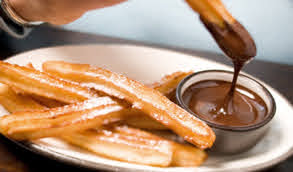
Long, crispy, and crunchy pastries. Soft and chewy inside. Amazingly fragrant, churros consist of deep-fried yeast dough encrusted with sugar. Eaten with hot melted chocolate sauce, for dipping.
Pączki, Poland

Absolute Polish favorite. Golden-brown with a characteristic light ring around the middle, and no hole. Yeast-risen doughnuts are deep fried and covered with powdered sugar or candied orange zest. Traditionally they are filled with an aromatic rose petal jam (and trust me it is delish!!). They are eaten all year round, but especially in millions eaten on Fat Thursday (the Thursday before Lent) as part of the zapusty, or “carnival season.”
Apple fritter, USA

One of the American classics. Delicious, deep-fried dough mixed with apples and cinnamon. Drizzled with vanilla flavored sweet glaze. Easy and quick to make. In less than thirty minutes, you can have this sweet, delicious treat.
Funnel cake, USA
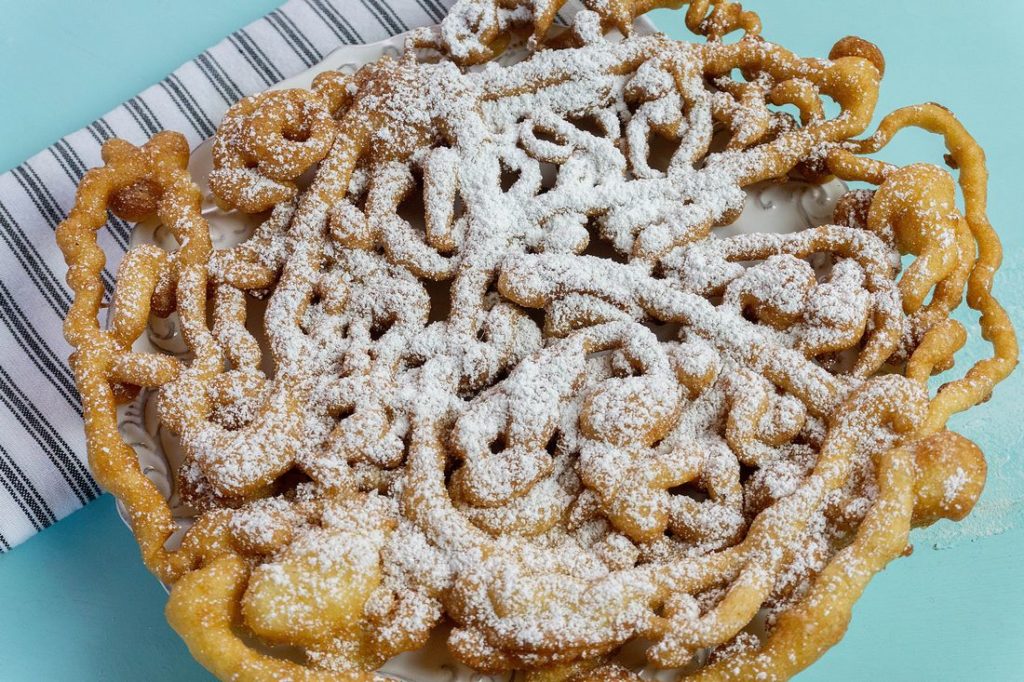
Essential part of every American street fair. The unusual name comes from the method of preparation (batter, made with eggs, sugar, milk, and baking soda, is poured through a funnel directly into the sizzling oil). The thin stream of batter is poured in circular motion over hot oil, it creates tangled, distinctive shape of this American delicacy. When fried, the batter expands, and the result is a crispy, golden brown treat. Dusted with powdered sugar, but other favorite condiments also include fresh fruit, jams, chocolate, whipped cream or caramel, candy.
Lokma, Turkey

This treat is well known far beyond Turkish borders. its origins reaching Ancient Greece, where they were given to winning Olympians as a treat and were called honey tokens (Loukoumades). Sugar-packed dessert is usually made with a mixture of flour, sugar, yeast, and salt, which is deep-fried and then bathed in syrup or honey. Extremely popular till this day is Greece, Turkey, and Cyprus.
Munkki, Finland

literally means “monks”, probably because the round shape resembles the monk’s hair do, and the brown color, is the color of the clothes in monastery. Deep fried Finnish doughnuts, round ones with the hole. Dusted in powder sugar. Occasionally made into full round shapes, filled with fruit jams and jellies. Today, Munkki are traditionally associated with May Day; the national festivity celebrated on May 1st.
Sufganiot, Israel

The Sufganiot, is a direct descendant of German krapfen, which was imported to Israel by German Jews who fled the Europe around the WWII time. The fully round, without a hole, jelly-filled sufganiyah is a traditionally consumed during the Jewish festival of Hanukkah (as a type of food fried in oil). Besides the typical strawberry jam filling, sufganiyah is nowadays available in multiple flavors such as Bavarian cream.
Pastel, Brazil
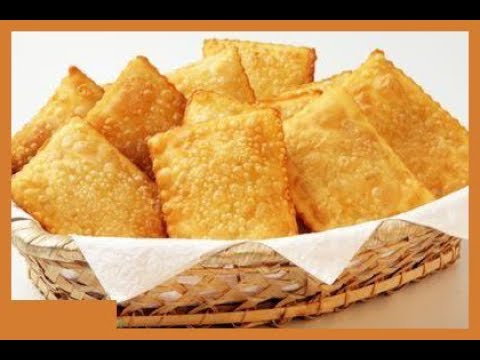
Most popular fast-food treat in Brazil. This half-circle or rectangle-shaped miniature pie is stuffed with a variety of ingredients, most commonly shredded chicken, ground beef, mozzarella, or small shrimps. Sweet version is usually made with chocolate, bananas, or guava jam, but they are not as popular and the savory ones. They are served hot and are most commonly accompanied by beer or a glass of sugarcane juice. Always meant to be eaten by hand.
Lángos, Hungary

Hungarian specialty. Basic dough mixture (water, flour, yeast, sugar, and salt) is deep fried until it develops a golden-brown color. Sometimes for a richer version, dairy (sour cream, milk, or yogurt) will be used instead of water. Lángos is best eaten fresh and warm, and it can be topped with anything from sour cream and grated cheese to garlic sauce and salt, although it is often consumed plain, as it is. This popular street food specialty can be found at numerous fairs, festivals, beaches, and amusement parks.
Chiacchiere, Italy
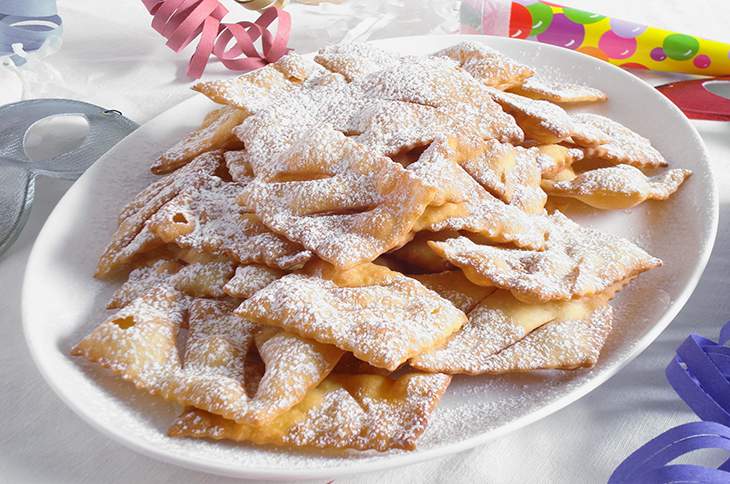
Italian carnival pastry fritters. Sometimes called angel wings due to their appearance. Thin sheets of dough are cut into thin strips, which are then twisted into ribbons or kept flat with wavy borders. They are then deep-fried and usually finished with a sprinkling of powdered sugar. This carnival treat has many names depending on the region, and every region in Italy seems to claim Chiacchiere as their own.
Fritule, Croatia
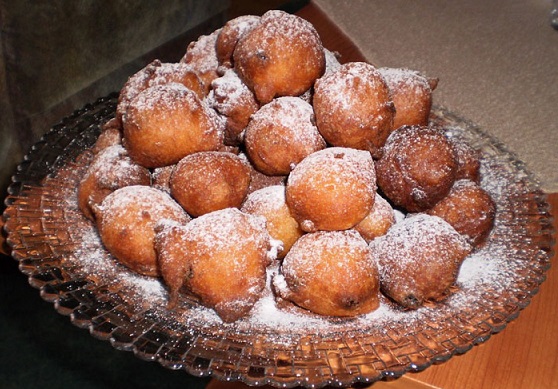
Croatian version of sweet, round fritters, with pleasant aroma and a distinctive flavor. They are prepared with a basic yeasted dough (eggs, flour, milk, butter, and sugar), with addition of raisins, grated apples, yogurt, and baking powder. The thick, buttery base is enriched with strong vanilla and citrus flavors. Plus there is a secret ingredient: Brandy, Rum, local fruit liquors, or other strong spirits are into the velvety dough( that allow the fritters to stay crispy and light without absorbing too much oil from the deep-frying process) Traditionally, Fritule are served dusted with powdered sugar.
Khaja, India
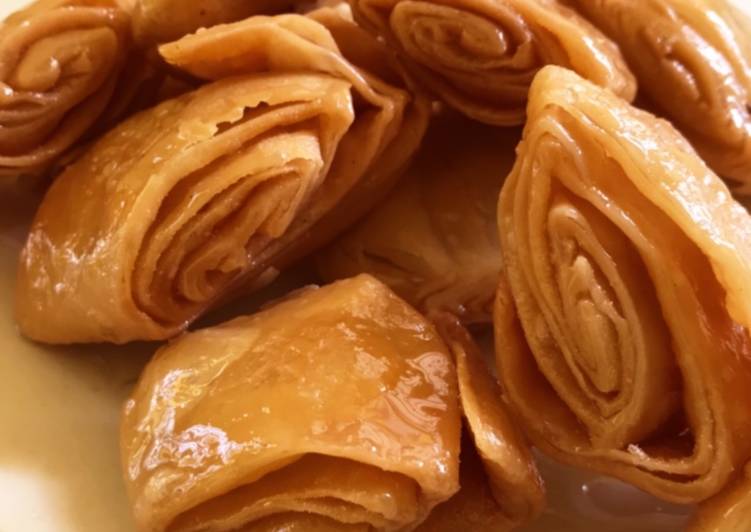
One of the traditional Indian desserts. Flour, sugar, and ghee-based dough that is deep-fried in oil until golden and crispy. After its cooked Khaja is sometimes soaked in sugar syrup.
tasty dessert is one of the key dishes at numerous North Indian wedding feasts. There are numerous regional varieties of Khaja. Regardless of the location all of them should have a wafery texture and melt in the mouth.
Bomboloni, Italy

Italian carnival, pillow-soft, airy, and amazingly light, deep-fried doughnut treats. Immensely popular and eaten throughout the year.
To the north of Italy, Bomboloni are simply sugar-coated, while in Lazio (Central district around Time) biting into their sugary crust reveals a silky cream on the inside. Bombolone Laziale are filled with either classic custard cream (crema pasticcera), or chocolate cream. The best enjoyed while they are still warm, regardless of the preferred variety.
Picarones, Peru

So called Peruvian doughnuts, are a staple of Peruvian street food. The traditional yeasty doughnut dough, with addition of sweet potatoes and squash to the dough, is shaped into a ring and fried in hot oil. Picarones are then drizzled with a sweet cane syrup.
Oliebol, Netherlands
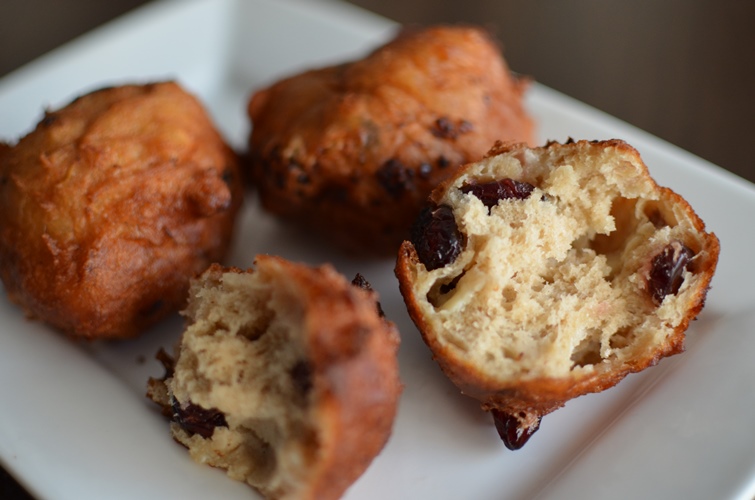
Literally translated as “oily ball”. The deep-fried dough is made with flour, eggs, yeast, milk, and baking powder. The outside is crunchy, while the center is chewy and soft., the fritters are sprinkled with powdered sugar, while some varieties have raisins or currants that are incorporated into the dough. Oliebollen are prepared and consumed at numerous fairs, and they are especially popular during the Christmas and New Year period.
Faworki, Poland

must have treat for Fat Thursday. Crispy angel wings. Thin and flaky dough cut into strips, with opening in the middle, that lets you loop the ends through it, and make a bow tie shape. Deep fried and always dusted in powder sugar.
Vdolky, Czech Republic

These soft, tender Czech doughnuts are prepared with yeasted dough that is often flavored with lemon zest. They are round and have a small bump on the top, which is used to hold all the scrumptious filling. They can be baked in the oven, but traditionally Vdolky are fried in deep oil until golden brown. Typically , they are enjoyed warm, covered in jams and topped with whipped cream or crumbled tvaroh ( Eastern Europe an cottage cheese).
Bola de Berlim, Brazil

Bolas de Berlim are Portuguese donuts that are sliced in half, then filled with sweet and creamy egg-based custard. Fluffy on the exterior and thick and creamy on the interior, these donuts are typically rolled in granulated sugar before being filled with the custard. On the Portuguese coast, vendors sell these tasty balls on numerous beaches, and locals love to consume them while sunbathing. Although bolas de Berlim are typically filled with custard, they can also be ordered sem creme, meaning without the creamy filling.
Struffoli, Italy

also known as Honey Balls is a dessert dish from Napoli, traditionally prepare during Christmas season. Made of deep-fried balls of sweet dough, that is formed into balls about the size of marbles. Crunchy on the outside and light inside. Struffoli are mixed with honey and other sweet ingredients and formed into mounds or rings. There are many ways to flavor them, but the traditional way is to mix them in honey with sprinkles, cinnamon, and bits of orange rind.
Timbits, Canada
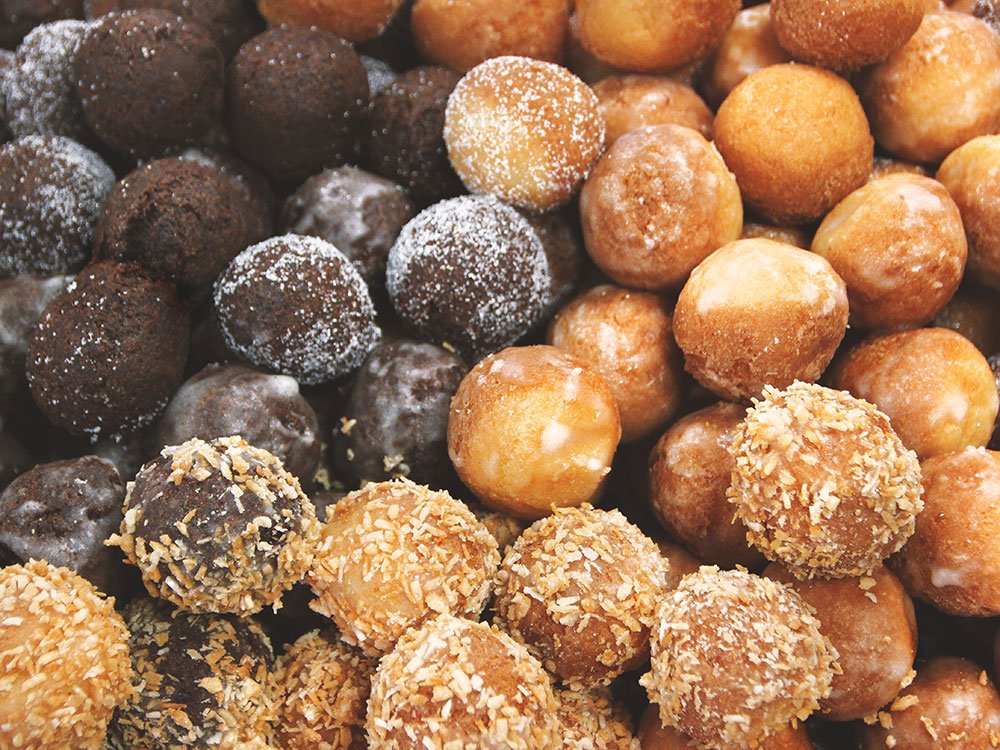
One bite-sized doughnut holes. Usually made from leftover dough, deep fried. Wildly available in many flavors: plain yeast, cake, apple fritter, honey dip, old fashion plain, chocolate glazed, blueberry, strawberry, lemon, and filled timbits. They are generally sold in North American fast food chains such as Tim Hortons and Dunkin’ Donuts ( in America they are called Munchkins).
Chebakia, Morocco

chewy, crunchy, and fragrant Moroccan pastry made by arranging strips of dough into a flower shape. It is then fried, coated in honey, and sprinkled with sesame seeds. The intricate looks make them even more special. This sweet treat is traditionally prepared during the month of Ramadan.
Filhós, Portugal
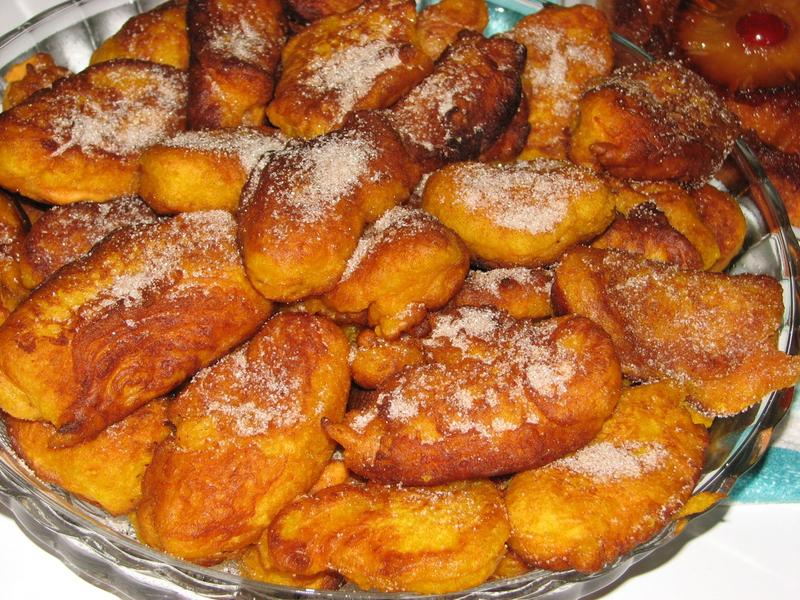
In their simplest form, filhós are traditional Portuguese deep-fried treats prepared with leavened dough. They come in numerous regional varieties that may differ in form and often incorporate different spices and additions such as pumpkin or orange juice. After frying, they are usually coated in cinnamon sugar, and in Algarve, they are occasionally dipped in brown sugar syrup. Although they are often associated with Christmas, filhós are enjoyed all year round. In some regions, the term filhós may refer to the round Portuguese-style doughnuts that are better known as malasadas.
Malasadas, Portugal
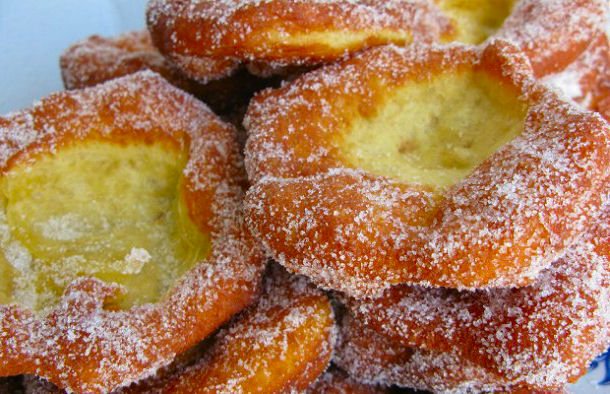
Second one of the popular Portuguese doughnut family. Made from sweet yeasty leavened dough. Fully round, without a hole or a filling. Traditionally dusted with powdered sugar or cinnamon.
Panada, Indonesia
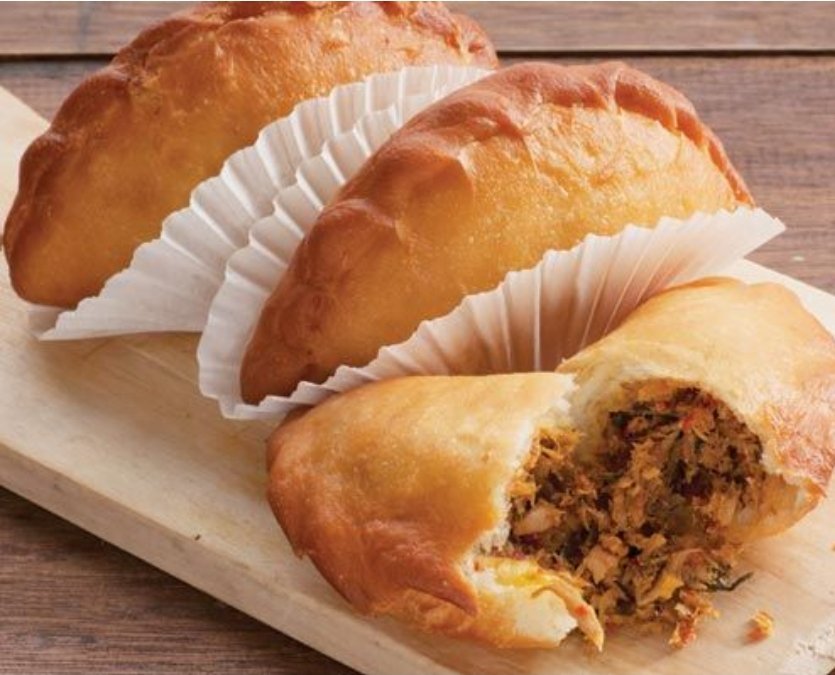
Indonesian take on Spanish empanadas (the name itself shows the connection). It is believed that the origin of panada was influenced by the Portuguese, who were present in the area since the 16th century. These deep-fried, crescent-shaped pastries consist of leavened dough and a fish-based filling. The Indonesian version is traditionally filled with a combination of skipjack tuna, onions, coconut milk, chili peppers, and other optional ingredients.
Bourekia, Cyprus

Traditional Cypriot pastry. Made with thin and flaky phyllo dough and filled with cheese. Semicircular in shape, pastries come in sweet or savory version. Both types are deep-fried in oil until golden brown.
The sweet version uses a combination of fresh, unsalted anari cheese (soft, slightly sweet Cypriot whey cheese), cinnamon, and sugar. Rosewater or citrus blossom water (orange blossom water) is used to enhance the filling’s flavor. The pastries are dusted with cinnamon sugar or soaked in honey or syrup. Savory bourekia, on the other hand, may contain various ingredients including ground meat, cheese (such as halloumi, graviera, or feta), spinach, or mushrooms. There is also a Lenten version of bourekia (known as bourekia nistisima) which calls for stuffing the phyllo dough with halva.
Diples, Greece
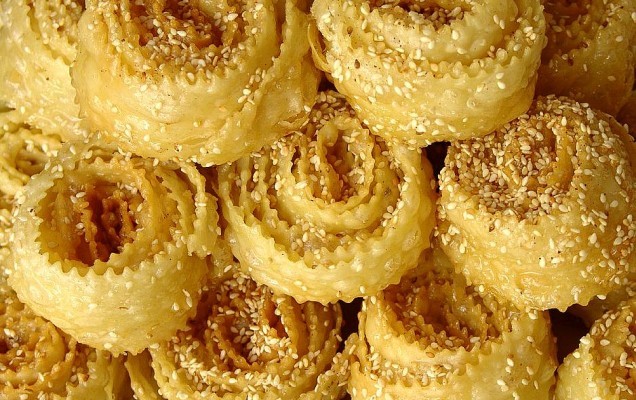
This Delicious dessert is made of extra thin pastry sheets that are rolled, deep-fried, and soaked or drizzled with a thick, honey-based syrup. These pastries can be formed into various shapes and are often sprinkled with nuts and dusted with cinnamon
Schneeballen, Germany
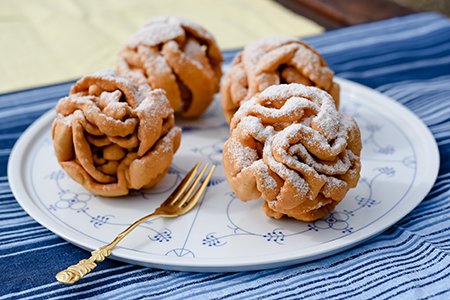
this German sweet treat looks little complicated. Thin strips of short crust pastry tangled into a ball shape. Deep fried until crispy, golden brown. Traditionally dusted in sugar, although it can be also covered with melted chocolate syrup, and sprinkled with chopped nuts, marzipan, cinnamon, or coconut flakes.
Koeksister, South Africa
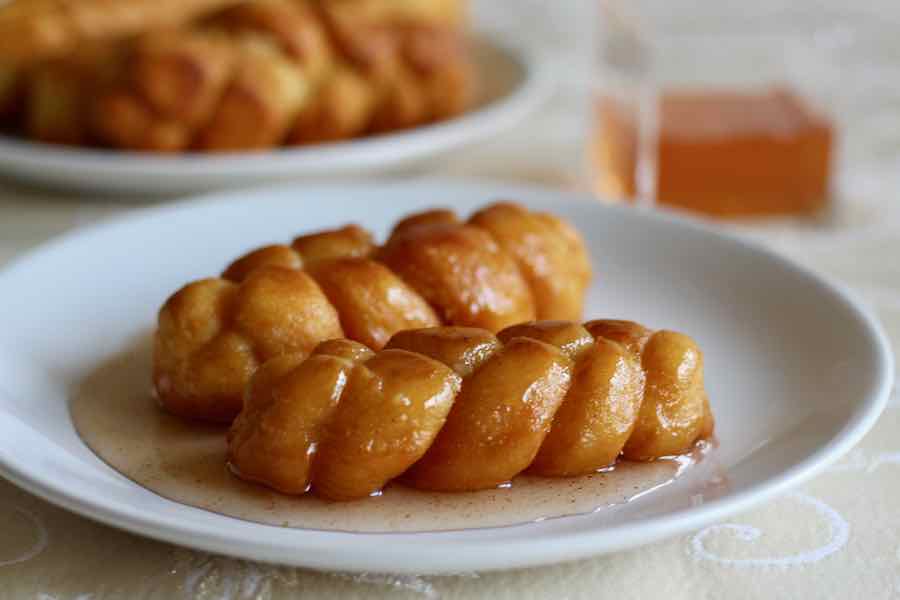
This pretty looking treat with a sticky appearance. It is prepared by frying braided dough strips in deep oil, then submerging them into a cold sugary syrup. These treats are sold on every major street in South Africa, and today they can even be found in most supermarkets. It is recommended to top them with cinnamon or lemon juice before consumption.
Gogoși, Romania
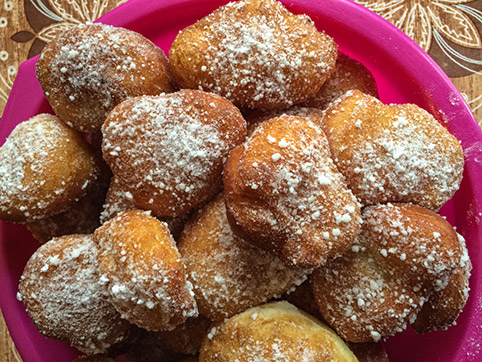
Doughnut the Romanian way. Dough mixture (prepared without yeast or butter) that is flavored with vanilla extract and grated lemon or orange peel. Spooned to the hot oil and deep-fried till golden brown. This methods results in different, irregular shapes, unlike the regular round-shaped donuts. A typical homemade treat, Gogoși can also be found. It is served warm with a generous dusting of icing sugar on top and can be filled with fruit jams or chocolate.
Sfenj, Morocco
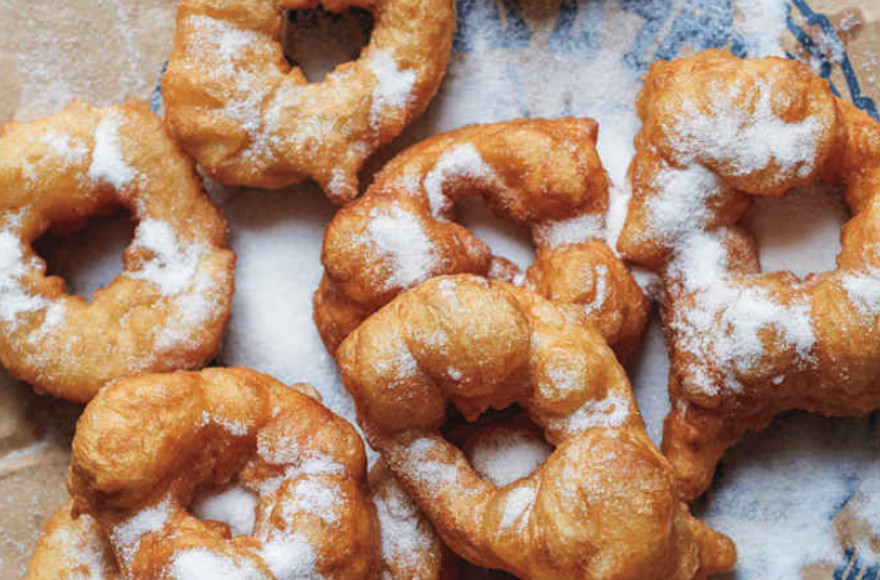
Sfenj are popular Moroccan doughnut-like fritters made from sticky unleavened batter. The dough is traditionally shaped into rings, by hand (which results in irregular shapes) and deep-fried until it is golden crispy on the outside. The inside should be fluffy, tender, and chewy. fritters are usually served hot, and they can be eaten plain or dusted with powder sugar.
Papanași, Romania
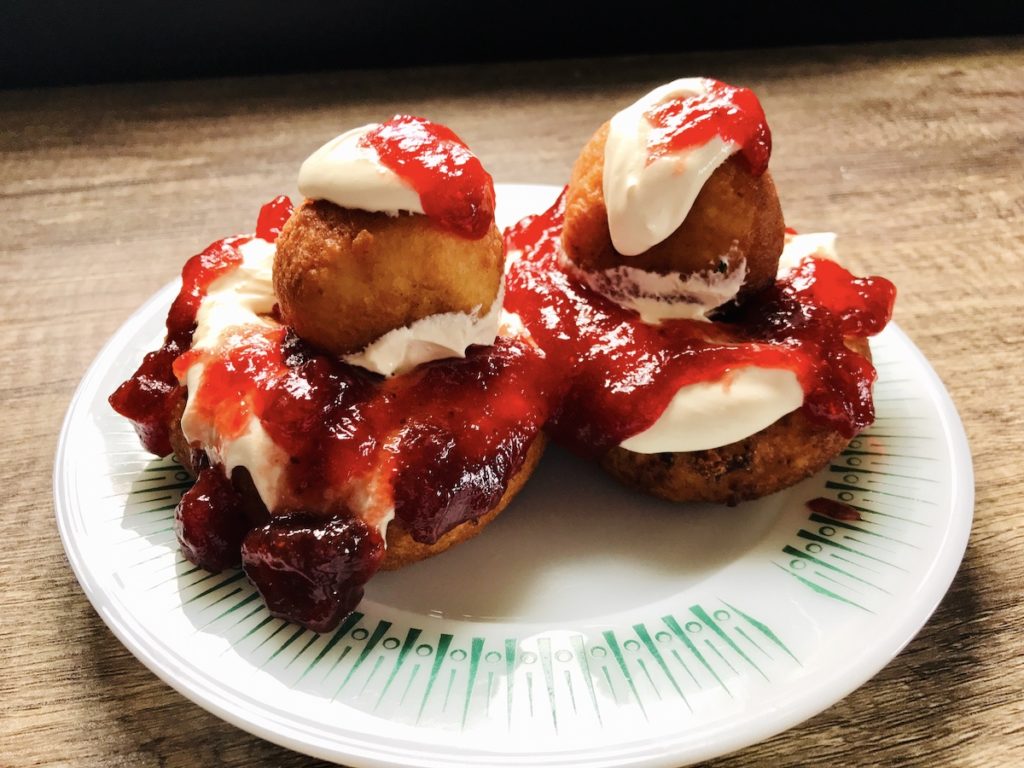
traditional Romanian donut-shaped pastry with a small bubble on top. It can be fried or boiled, and it is made by adding unsalted cheese such as brânză de vaci (cow’s milk cheese) or urdă to a regular flour and egg dough. The fried papanași are usually donut-shaped and can be served with fruit jams, a dollop of sour cream, or powdered sugar. The boiled varieties are smaller, nugget-shaped, and typically coated with a mix of breadcrumbs and sugar.
Skruzdėlynas, Lithuania
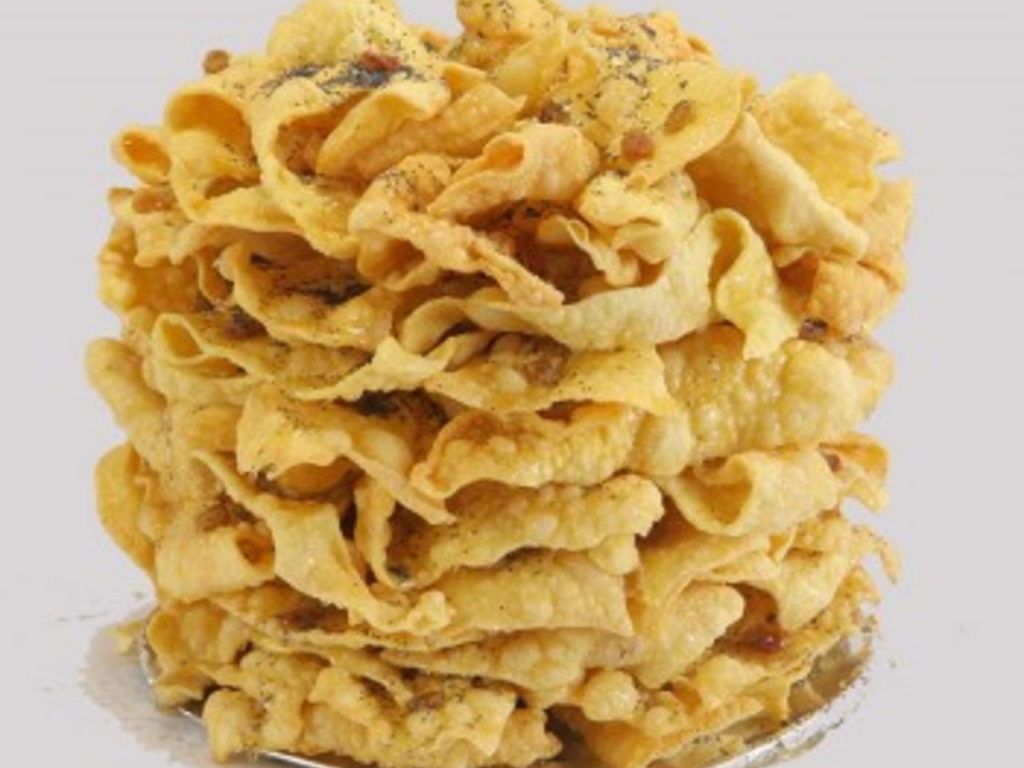
Lithuanian architectural dessert. Deep-fried pieces of dough are stacked on top of one each other, then glazed with honey syrup and sprinkled with poppy seeds. The dough (flour, eggs, a pinch of salt, and (optionally) sour cream), is rolled out very thinly and cut into small, rectangular pieces which are then deep fried. The syrup (honey, butter, sour cream, and a little water), is drizzled over each piece of dough. Finally, poppy seeds are sprinkled over the honey-dripping stack of pastries.
Mandaazi, Tanzania

African coconut doughnut. Triangle shaped, made with sweet yeast dough, coconut milk and coconut flakes. Deep fry until deep golden brown and dusted with powdered sugar. Best served hot.
Klenät, Sweden

The rhomb-shaped, crispy klenät is a popular deep-fried pastry enjoyed in many Nordic countries. Made with the buttery yeasted dough, often enriched with various liqueurs, it is primarily rolled, shaped into a knotted trapezoid, and then fried until it turns into a light, crunchy, golden treat. By Traditionally enjoyed during Christmastime, it is best served freshly prepared and lightly sprinkled with cinnamon and powdered sugar.
Chin Chin, Nigeria

popular snack in Nigeria. The batter is made with flour, sugar, butter or margarine, and milk, ground nutmeg, baking powder, and eggs. The stretchy and sticky dough is rolled and cut into shapes (generally small squares or strips) before being fried in hot vegetable oil until golden brown. These traditional snacks can be either crunchy or hard, depending on the preparation.
Nonnevot, Netherlands

This traditional pastry dating back to at least the 17th century. The dough is prepared with flour, yeast, milk, salt, butter, lard, and brown sugar. It is then deep-fried until it develops a golden-brown color. Although Nonnevot has traditionally been associated with the carnival, today it can be bought in many regional bakeries.
Fun fact*
The unusual name of this pastry means nun’s butt. and it is referring to its knotted shape and the knot on the back of a nun’s uniform.
Rosco’s fritos, Spain
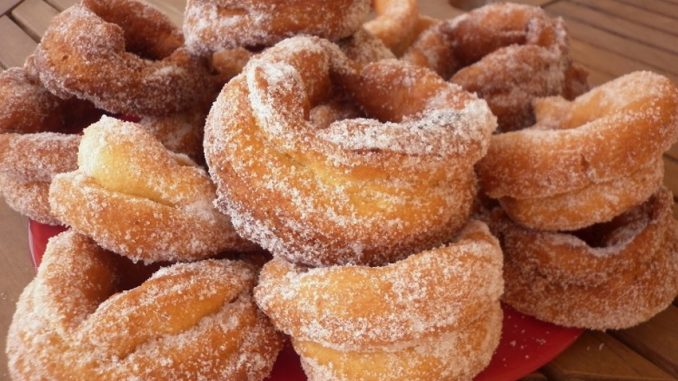
Spanish invention, like donuts, but with a different texture. The dough (made with eggs, sugar, flour, oil, and grated lemon rind). It is shaped into donut rings, then fried until golden. Rosco’s are traditionally rolled in sugar after being fried. Although the place of origin of roscoes’ fritos is thought to be in Andalusia, these sweet treats are nowadays consumed throughout the country, especially during the Easter festivities.
Bolas de fraile – Argentina

Bolas de fraile is the Argentine version of a doughnut. It is made without a hole in the center, and the doughnut is filled with dulce de leche, then dusted with powdered sugar. It is believed that bolas de fraile is derived from a popular Germany pastry called Berliner Pfannkuchen. The name of these tasty doughnuts means balls of weakness, and it is said that the name was invented by anty-clergy anarchists who wanted to oppose a harsh regime that was imposed by the Catholic church.
Hot jam doughnuts, Australia

Australian specialty pastry from Melbourne, which is why it is also affectionately known as the Melbourner. Unlike most other donuts, these ones are always served hot. The donuts are made with yeasted dough (must be proved twice), filled with red jam before it goes in the fryer. They are designed to be eaten fresh and hot, and once cooked, crispy on the outside and pillowy on the inside, the donuts are coated in sugar.
Kaimati, Kenya

Kaimati are sweet Kenyan dumplings. The dough ( flour, water, yogurt, yeast, and ghee), is fried in oil until golden brown, then coated in sugar syrup ( made with sugar, water, lemon rinds, and a pinch of vanilla sugar or cardamom powder).These sweet treats are especially popular during the month of Ramadan as a dessert or a snack.
Róża karnawałowa, Poland

This elegant, rose-shaped dessert is prepared with the same sweet pastry as the Faworki (see up). The name came to be, due to its typical shape and the tradition of making it during the carnival season, meaning carnival rosette. Each piece has three to five pastry disks of different sizes that are stacked on top of each other, with the smallest one being on top, with small slits on the edges, and pressed together , in the middle , creating one piece. Once fried, the dessert is dusted with powdered sugar and adorned with a dollop of jam. Light and airy, this dessert is a perfect addition to the traditional festive table on Fat Thursday, the last day of the carnival season in Poland.
Athirasa, Sri Lanka

Traditional sweet made with a combination of rice flour, roasted rice, coconut treacle, coconut oil, and cardamom. All the ingredients are mixed well together and formed into a stiff paste that is portioned into flat discs and deep-fried in hot oil. Traditionally prepared for festive occasions. Apart from Sri Lanka, this sweet treat is also popular in India during Diwali.
Loukomades, Greece

The name of this sweet doughnut like treat, comes from the Greek word, meaning a bubble. Which picturesque describe the small spherical shape of the fluffy fried pieces of dough.
These donuts are typically made with a simple batter of flour, water, and yeast, and once deep-fried in oil, they are usually eaten while still warm. usually enjoyed drizzled with honey on top and sprinkled with cinnamon or nuts, although they can also be accompanied by scoops of ice cream on the side.
Cannoli, Italy

Sicily’s best-known dessert, that originated somewhere around 9th century. The recipe easy first made in woman’s harems on Saracen court. Those crispy fried pastry tubes filled with decadent sweet ricotta cheese cream. The edges are adorned with crushed pistachios, or chocolate bits. Served chilled, dusted with powdered sugar.



